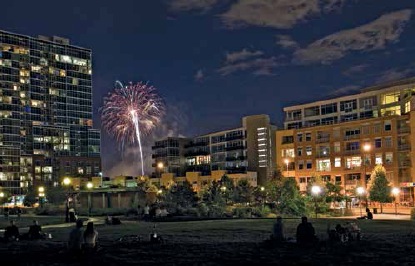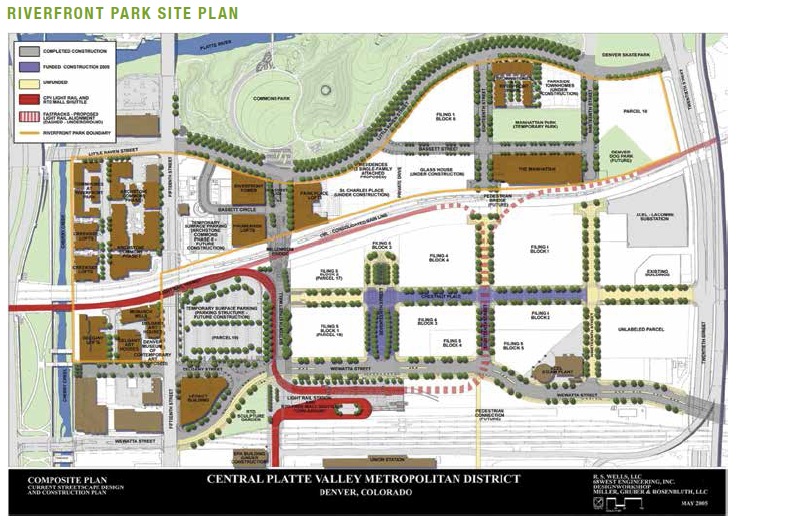URBAN LAND INSTITUTE
Project Summary
 Riverfront Park is an urban infill planned community that currently includes 1,859 rental and for-sale housing units in 14 buildings, 49,000 square feet of retail and restaurant space, a museum, and three parks on a 23-acre site adjacent to downtown Denver. Initiated by the city of Denver on former railroad land, the project involved a firm that assembled and rezoned the land and a second partnership of firms that undertook much of the development and construction. The project is arranged in a linear fashion between railroad tracks on one side and a 19-acre park developed by the city on the other, and is connected to the downtown by an iconic pedestrian bridge that spans the railroad tracks.
Riverfront Park is an urban infill planned community that currently includes 1,859 rental and for-sale housing units in 14 buildings, 49,000 square feet of retail and restaurant space, a museum, and three parks on a 23-acre site adjacent to downtown Denver. Initiated by the city of Denver on former railroad land, the project involved a firm that assembled and rezoned the land and a second partnership of firms that undertook much of the development and construction. The project is arranged in a linear fashion between railroad tracks on one side and a 19-acre park developed by the city on the other, and is connected to the downtown by an iconic pedestrian bridge that spans the railroad tracks.
Riverfront Park is the result of a 25-year collaboration
to create a viable and vibrant urban
residential community in downtown Denver. Built
under a form-based zoning code, the development
encompasses 1,859 privately developed,
for-sale, for-rent, and affordable homes, with
buildings first opening in 2001 and with construction
still underway in 2014. The neighborhood fits within the city’s grid and is connected
to surrounding areas by four pedestrian bridges
that cross railroad tracks, an interstate highway,
and a river, each funded through a combination
of public and private investment. Built on a
brownfield and former rail yard, the project was
an early model of sustainability. Today, residents
can play, wander, skate, swim, and walk their dogs along dedicated non-vehicular pathways or
in four different parks built by the state, the city,
the developer, donors, and residents.
The Site
Denver was founded at the confluence of two
quiet waterways, the South Platte River and
Cherry Creek, where gold was first discovered
in the Denver region. Over the city’s history, the
waterfront has transitioned from an outpost to
a boomtown to rail yards to a shantytown to a
flood zone to a light-industrial park and now,
finally, into a bustling downtown residential
neighborhood. Just prior to redevelopment, the
site was owned for many years by the Burlington
Northern Railroad and included a huge rail yard
and many tracks, as well as some old industrial
warehouses that had to be demolished.
The Riverfront Park community and the
adjacent Commons Park are located at the
historic heart of Denver, at the confluence of
these two rivers. The site, including the park, is
bordered on the northwest by the South Platte
River, on the southwest by Cherry Creek, on the
southeast by the railroad lines and the Union
Station project and downtown Denver (with two
pedestrian bridges that span the tracks), and on
the northeast by 20th Street, a major arterial.
The site offers immediate access to Interstate
25 via two nearby freeway interchanges. The
site also benefits from a recently added pedestrian
bridge across I-25 that connects Riverfront
Park with neighborhoods to the north.
The Idea and the Development Team
The idea behind the project emanated from
several sources, including the city of Denver,
which had a vision for redeveloping the
railroad yards and adding parkland and new
development to the area; Trillium Corporation,
which bought the land from the railroad and
worked with the city to plan and entitle the
area for redevelopment; East West Partners
(EWP), a resort developer that ultimately
purchased the land and became the master
developer for the project; and Crescent Real
Estate Equities, which partnered with East
West on development and provided critical
equity financing to make the project happen.
The idea and the vision for the project
began during the 1980s with Mayor Federico
Peña, who started a dialogue with the railroads
about consolidating their railroad lines into fewer tracks, and redeveloping the excess
land. In 1991, Trillium Corporation, led by its
founder and chairman, David Syre, acquired
several hundred parcels of land from Burlington
Northern Railroad, including several excess
parcels located in downtown Denver near the
South Platte River that were no longer needed
for railroad uses. The site that Trillium acquired
included all of the land where Riverfront Park
and Commons Park are located, as well as a
partial interest in the adjacent Union Station
parcel on the other side of the tracks.
At the same time, the city was hoping to
start a redevelopment process in the area, following
on the success that had been achieved
in the LoDo area of downtown Denver. The
city had been making plans for the area under
both Mayor Peña and Mayor Wellington Webb,
and this would continue under Mayor John W.
Hickenlooper Jr. Notably, Mayor Webb took
office in 1991, and one of his major goals was
to build and improve the Denver park system,
which led to the Commons Park idea.
Once the railroads had consolidated the rail
yard into a narrower channel and fewer tracks,
Trillium brought in Design Workshop to help with
a planning and design study to develop a concept
plan and design guidelines for the newly
available land. A public process was undertaken
to prepare and execute a 21-block infrastructure
and development plan. In the mid-1990s, a special
district—the Central Platte River Metropolitan
District—was established, and thereafter
Trillium Corporation sold approximately 25 acres
of land along the South Platte River to the city
of Denver for the development of a new park,
which was a part of that plan.
In 1996, Harry Frampton and Mark Smith
of East West Partners, a resort development
firm based in Beaver Creek, Colorado, heard
the mayor of Denver speak at a ULI event
in Denver about plans for the South Platte
River area, and they subsequently decided to
investigate the prospects for buying land and
developing in the area.
In April 1999, East West Partners, together
with the firm’s longtime equity partner,
Crescent Real Estate, purchased 22.65 acres
of entitled land from Trillium Corporation and
began the process of redeveloping that site
into what is now called Riverfront Park. One
of the main reasons they were attracted to the
property was the Commons Park. Their vision
for the project, while similar to the city’s vision,
was framed by their experience as resort developers.
They had spent much of their careers
developing resort communities and mixed-use
villages oriented around mountain and ski
amenities. Riverfront Park, they believed, could
be thought of in a similar fashion, but with the
city and the nearby Commons Park and Platte
River as the amenities. Their objective was to create a quiet urban residential neighborhood
with easy access to the urban park and downtown
Denver. To a certain degree, they thought
of the project as an urban resort.

Download full version (PDF): Riverfront Park Case Study
About Urban Land Institute
www.uli.org
“The mission of the Urban Land Institute (ULI) is to provide leadership in the responsible use of land and in creating and sustaining thriving communities worldwide. Founded in 1936, the institute now has more than 40,000 members worldwide representing the entire spectrum of land use and real estate development disciplines, working in private enterprise and public service.” – See more at: https://www.infrastructureusa.org/climate-change-land-use-and-energy-2010/#sthash.eqY07uwJ.dpuf
Tags: CO, colorado, Denver, Riverfront Park, ULI, Urban land Institute






 RSS Feed
RSS Feed